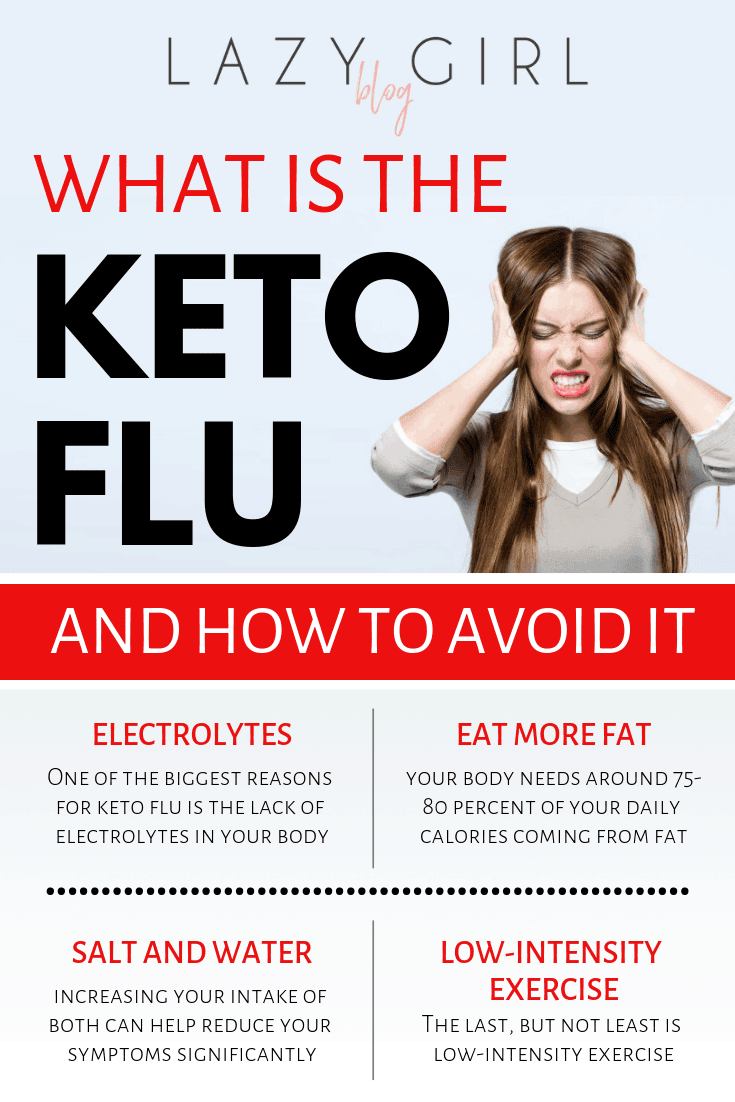The keto flu is almost a necessary evil, to enter the gates of ketosis. The keto flu is your body’s natural way of reacting to the lack of carbs.
If you recently began a low carb or Ketogenic diet you are bound to get symptoms of what is known as the Keto flu. You will actually get symptoms of the flu for up to 1 week.

Some people experience the Keto flu for only a day or 2 but most feel the symptoms for a full week. Of course, there are always extreme cases, where the flu can last up to 30 days, but that is very rare.
Like most people, you probably have to feed your body a significant amount of carbs most of your life.
Our bodies and brain are perfectly happy with carbs and have adapted to them through hormonal and metabolic processes, which normally run in the background.
Try to think positive and keep believing your body will adapt. Symptoms will go away, and most importantly just stay psychologically strong.
Switching fuel sources will likely be a drastic shock for your body, at first. In a nutshell, keto flu is a name for a set of symptoms, that you will experience, on the way to ketosis.
It is not flu and it’s definitely not contagious, but it is annoying.
Cutting out these types of foods might be a bit of a shock to your body, but it will start to put it on the right path to a much healthier you.
Your body is more than likely dependent on the carbs you choose to eat on a daily basis. Because of this, your body will start to experience the symptoms of the flu.
This post may contain affiliate links. As an Amazon Associate, I earn from qualifying purchases for my referral at no extra cost to you! See Disclosure
Symptoms of the Keto Flu
The symptoms of the keto flu will vary between individuals. There are some symptoms that are almost sure signs of the keto flu once you start the diet:
- Nausea
- Sniffles
- Dizziness
- Irritability
- Stomach Discomfort
- Difficulty focusing (“brain fog”)
- Tiredness
- Insomnia
- Sugar Cravings
- Headache
- Muscle Soreness
- Sore Throat
Try not to be alarmed when you start getting these symptoms after beginning the diet. Your body just needs to adjust to what you’re starting to put it through.
I can tell you from personal experience that having these symptoms is no fun at all. It sucks. It makes you wonder if starting this diet is even worth it. But the good news is, that this is not going to last forever.
These feelings and symptoms will eventually go away once your body starts to enter ketosis.
Avoiding the Flu
1. Electrolytes
One of the best ways to try and curb the symptoms of the keto flu is to replenish your electrolytes. One of the biggest reasons for keto flu is the lack of electrolytes in your body.
Electrolytes affect many important parts of our bodies like water amount and muscle function.
The electrolytes that you’re losing are magnesium, potassium, and sodium. When sodium levels drop in the body so do your potassium levels when the body expels it through urine.
Sodium and potassium require a careful balance in the body to control fluid stability in cells.
Potassium deficiency symptoms are closely related to keto flu with fatigue, cramps, and muscle weakness the main signs.
There are ways to keep the potassium level raised either through diet or supplementation.
So how do you make sure you keep enough electrolytes in your system?
You can supplement your water with a water enhancer like Mio Electrolytes Berry Blast.
You can also eat more foods that contain sodium or if you’re a fan of hot sauce drown your food in it. Don’t hesitate to add salt to your meals as well.
Some people like to drink a cup of chicken broth daily. Bone broth is probably one of the easiest ways to alleviate your keto flu symptoms.
It is also an easy way to sneak more water into your diet together with electrolytes (e.g. sodium and potassium). Just make sure you find zero-carb chicken broth and add some salt to it.
Natural food sources including dark leafy greens, e.g., spinach are high in potassium. Meat and Fish also play a role, but usually, you’ll have more than enough anyway.
The last crucial mineral for assisting to avoid keto flu is the electrolyte magnesium. Magnesium plays a significant role in every cell in our body.
During keto-adaptation, magnesium levels tend to drop causing flu symptoms. Without enough magnesium consumption, potassium and sodium may also be affected.
If you can keep up your electrolyte intake then you’ll be fine.
2. Increase Calories – Eat more fat
You should definitely be aware of the number of calories that you are consuming in a Keto diet. But the transition into Ketosis may require you to increase your calorie intake temporarily to combat the Keto flu. Keto Cheesecake Fat Bombs are a delicious way to quickly increase your calories and healthy fats in a low-carb way. I keep them on hand at all times!
In order to stay in ketosis, your body needs around 75-80 percent of your daily calories to come from fat, 5% percent need to come from carbs and the rest from protein. Increasing the amount of fat you are eating, will help to speed up the process and it will make you feel more satiated.
After following the ketogenic diet for a while, you will soon get used to finding different ways to add fat, using new meals and Keto recipes, and eventually, you’ll get the hang of it.
So around 20% percent of your calories need to come from protein. If you get too much protein, your body is going to start converting the excess into glucose just as it does with carbs and keep you out of ketosis.
During the adaption phase, don’t worry so much about being in a caloric deficit (this can do more harm than good in the beginning).
3. Lemon Water with Sea Salt
This is the absolute best drink to have all day to stave off the Keto flu. Every time I began to suffer from a bit of nausea after a high-fat low-carb meal I’d a have few glasses of lemon water with sea salt. It is the most amazing trick to satiating your cravings and combating carb withdrawal symptoms. The sea salt (Himalayan salt works wonders too) will help replenish your body with electrolytes that you desperately need during this diet transition.
4. Low-intensity exercise – Take it easy with physical activity
Last, but not least is low-intensity exercise. Once you get up in the morning, the first ideal thing you can do to improve the keto flu is to take a bottle of water and go for a brisk walk (before eating). The idea behind a morning walk is that I help to deplete the glycogen stores in your body, thus transferring faster into ketosis. Walking just after waking up has other good benefits as well, like waking up and feeling better and more energized.
If you are weight training in the gym, make sure you’re allowing yourself enough time to rest if you’re working out.
As you can see, conquering the keto flu isn’t rocket science. You just need to be consistent and listen to your body. At first, the keto flu can seem like a punishment, but in reality, it’s a sign that you are on the right track with your diet. Just give your body some time to adapt, be hydrated and eat more fats. Then you will be in ketosis in no time and you don’t even remember what the heck keto flu was all about.
Once you pass the 1-week mark you’re going to feel great, your energy will be elevated as your body makes the switch, and you’ll be triumphal for staying strong.
If you have some symptoms of electrolyte imbalance, then consider yourself unlucky.
Just stay confident, keep moving forward, keep electrolytes topped up, and you’ll beat the keto flu.
Give it a few days to a week and let your body adjust naturally to a ketogenic diet.
